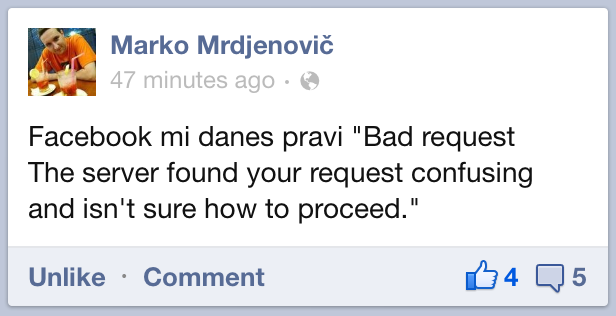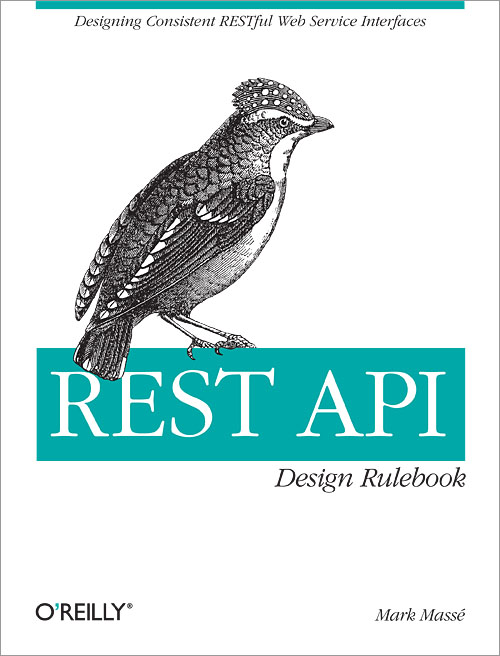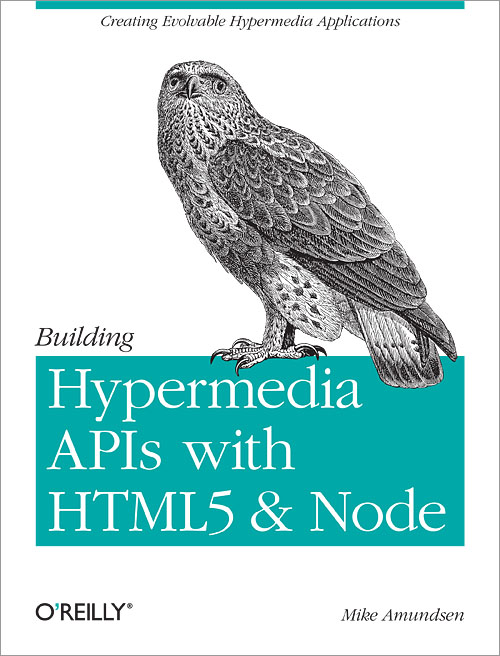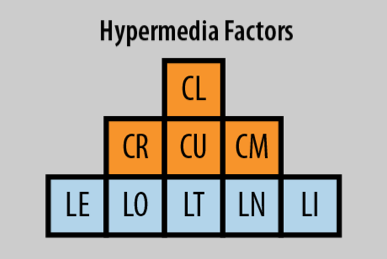API
State of the art
@mihahribar

@toshl
How we build APIs today?
- SOAP
- RPC
- REST
Define: REST
REpresentational State Transfer (REST) is a style of software architecture for distributed systems such as the World Wide Web.
Define: RESTful API
A RESTful API is a web service implemented using HTTP and the principles of REST.
Roy Fielding doctoral dissertation, 2000.
Constraints
-
Client-server
Separate clients and servers.
-
Stateless server
Each request from the client contains all the information necessary to service the request.
-
Cacheable
Clients can cache responses, if permitted by the server.
-
Layered system
Load balancers, proxies, firewalls etc.
-
Code on demand (optional)
Client can request code from server and execute it.
-
Uniform interface
Between the client and the server.
Uniform Interface
-
Identification of resources
Through URI.
api.toshl.com/users/42 -
Manipulation of resources
POST, GET, PUT/PATCH, DELETE
-
Self-descriptive messages
Through meta data.
-
Hypermedia as the engine of application state
HATEOAS, huh?
Define: HATEOAS
A client interacts with a network application entirely through hypermedia provided dynamically by application servers. A REST client needs no prior knowledge about how to interact with any particular application or server beyond a generic understanding of hypermedia.
In HTML <a>, <form>, <img> etc.
Let's jump in

Think things through
When in doubt
Check the spec RFC 2616.
URI Structure
- Collections
- Resources
- Controllers
https://api.toshl.com/expenses
https://api.toshl.com/expenses/42
https://api.toshl.com/budgets
https://api.toshl.com/export
Help a client out
$ curl -v https://api.toshl.com
> GET / HTTP/1.1
>
< HTTP/1.1 204 No Content
< Allow: GET
< Link: </expenses>; rel="expenses",</expenses/tags>; rel="expense tags",</incomes>; rel="incomes",...
< Content-Length: 0
< Content-Type: application/jsonInclude a handy Link header.
CRUD
- POST = Create
- GET = Read
- PUT/PATCH = Update
- DELETE = Delete
$ curl -v https://api.toshl.com/expenses
> GET / HTTP/1.1
>
< HTTP/1.1 200 OK
< Allow: GET, POST, HEADUse correct response status codes
- 200 (OK)
- 201 (Created)
- 202 (Accepted)
- 204 (No Content)
Create
$ curl -v -X POST -d "..." https://api.toshl.com/expenses
> POST /expenses HTTP/1.1
>
< HTTP/1.1 201 Created
< Allow: GET,POST
< Location: /expenses/1031
< Content-Length: 176
< Content-Type: application/json
<
{"id":1031,"amount":100,"currency":"EUR","rate":1,"date":"2012-10-23","desc":null,"tags":["food"],"loc":["0.000000","0.000000"],"modified":"2012-10-23T19:20:46+00:00Z","repeat":null,"extra":null}Spot the error?
Create
$ curl -v -X POST -d "..." https://api.toshl.com/expenses
> POST /expenses HTTP/1.1
>
< HTTP/1.1 201 Created
< Allow: GET,POST
< Location: /expenses/1031
< Content-Length: 200
< Content-Type: application/json
<
{"id":1031,"href":"/expenses/1031","amount":100,"currency":"EUR","rate":1,"date":"2012-10-23","desc":null,"tags":["food"],"loc":["0.000000","0.000000"],"modified":"2012-10-23T19:20:46+00:00Z","repeat":null,"extra":null}HATEOAS - include a link to the resource URI.
Read
$ curl -v https://api.toshl.com/expenses/1031
> GET /expenses/1031 HTTP/1.1
>
< HTTP/1.1 200 OK
< Allow: GET,PUT,PATCH,DELETE
< Content-Length: 219
< Content-Type: application/json
<
{"id":1031,"href":"/expenses/1031","amount":100,"currency":"EUR","rate":1,"date":"2012-10-23","desc":null,"tags":["food"],"loc":["0.000000","0.000000"],"modified":"2012-10-23T19:20:46+00:00Z","repeat":null,"extra":null}Update
$ curl -v -X PUT -d "..." https://api.toshl.com/expenses/1031
> PUT /expenses/1031 HTTP/1.1
>
< HTTP/1.1 200 OK
< Allow: GET,PUT,PATCH,DELETE
< Content-Length: 219
< Content-Type: application/json
<
{"id":1031,"href":"/expenses/1031","amount":200,"currency":"EUR","rate":1,"date":"2012-10-23","desc":null,"tags":["food"],"loc":["0.000000","0.000000"],"modified":"2012-10-23T19:20:46+00:00Z","repeat":null,"extra":null}GET and PUT are idempotent methods.
Delete
$ curl -v -X DELETE https://api.toshl.com/expenses/1031
> DELETE /expenses/1031 HTTP/1.1
>
< HTTP/1.1 204 No Content
< Allow: GET,PUT,PATCH,DELETE
< Content-Length: 0
< Content-Type: application/json
<Programmers are people too


Errors
- 400 (Bad Request)
- 401 (Unauthorized)
- 403 (Forbidden)
- 404 (Not Found)
- 405 (Method Not Allowed)
- 409 (Conflict)
- 500 (Internal Server Error)
- 503 (Service Unavailable)
- 418 (?) I'm a teapot
{
"id": "income_limit"
"description": "Income limit reached."
}Media Types
- Format specification and parsing rules
application/jsonapplication/vnd.toshl+jsonapplication/vnd.toshl.expense+json
Versioning
-
URI
https://api.toshl.com/v1/expenses/ -
Media Types
application/vnd.toshl.v1+json application/vnd.toshl.expense.v1+json
Pagination
https://api.toshl.com/expenses?page=1&per_page=20What about previous/next/last links?
$ curl -v https://api.toshl.com/expenses
> GET / HTTP/1.1
>
< HTTP/1.1 200 OK
< Allow: GET, POST
< Link: <expenses?page=2>; rel="next",<expenses?page=9>; rel="last"Date & time
Timestamp 2012-10-23T22:05:37+00:00Z. ISO 8601.
Sync
Add
?since=1351033818Add
?since_id=37821-
Using
Last-ModifiedandIf-Modified-Since -
Using
Last-Modifiedand?since=2012-10-23T22:05:37+00:00Z
Caching
- Server responds with
ETag: "3e12ec4d-994fefe4-24c8868" - Client can then send
If-None-Match: "3e12ec4d-994fefe4-24c8868" - If not modified, server responds with 304 (Not Modified)
Security
- Basic auth
- OAuth 1.0
-
OAuth 2.0
GET /expenses HTTP/1.1 Host: api.toshl.com Authorization: Bearer vF9dft4qmT -
OAuth 2.0 + MAC
GET /expenses HTTP/1.1 Host: api.toshl.com Authorization: MAC id="h480djs93hd8", nonce="264095:dj83hs9s", mac="SLDJd4mg43cjQfElUs3Qub4L6xE="
Are we there yet?
- We expose our objects by type-marshaling/serialization
- Create special media types for each object
- Smack a CRUD interface on top of it
- And call it an API
But then
- Update the API, clients break
- Update process, rewrite clients
- Versioning doesn't help
- Simple data, complex client
- Shouldn't that be the other way round?
Define: HATEOAS (again)
A client interacts with a network application entirely through hypermedia provided dynamically by application servers. A REST client needs no prior knowledge about how to interact with any particular application or server beyond a generic understanding of hypermedia.
Close but no cigar

Standing on the shoulders of giants
The WWW is fundamentally a distributed hypermedia application. —Richard Taylor
APIs and clients, they are hiding in plain sight.
Websites, HTML and the browser.

Explain
- Point the browser to a web page
- Browser executes a
GET page. - If the user clicks a link, construct a
GET urirequest. - If the user submits a form, construct a
POST uri "data"request.
Complex data, simple client
- Server can update independent from the client
- Clients don't break
- Clients don't have to know anything about your data
- Just how to parse it and present it
- Execute custom code on the client
Why don't we build APIs this way?


Define: WRML
Web Resource Modeling Language
WRML, pronounced like "Wormle", is an open source project focused on providing standards, frameworks, and tools that support the development of web-oriented, client-server applications.
> GET /common/Collection HTTP/1.1 Host: api.schemas.wrml.org
< HTTP/1.1 200 OK
< Content-Type: application/wrml;
< format="http://api.formats.wrml.org/application/json"; schema="http://api.schemas.wrml.org/common/Collection"
{"name" : "Collection", ...}
Hypermedia APIs
- Use HTTP correctly
- Serve hypermedia responses
- Expose processes not objects
Hypermedia factors

- LO Outbound Links
- LT Templated Links
- LI Idempotent Links
- LN Non-Idempotent Links
- Embed Links
- CU Update Controls
- CM Method Controls
- CL Link Annotation Controls
Mind blown

Collection+JSON
// sample collection object
{
"collection" : {
"version" : "1.0",
"href" : URI,
"links" : [ARRAY],
"items : [ARRAY],
"queries" : [ARRAY],
"template" : {OBJECT},
"error" : {OBJECT}
}
}Conclusion
- Complex data, simple client
- Expose your processes not your objects
- Let your API evolve
- Build Hypermedia APIs
